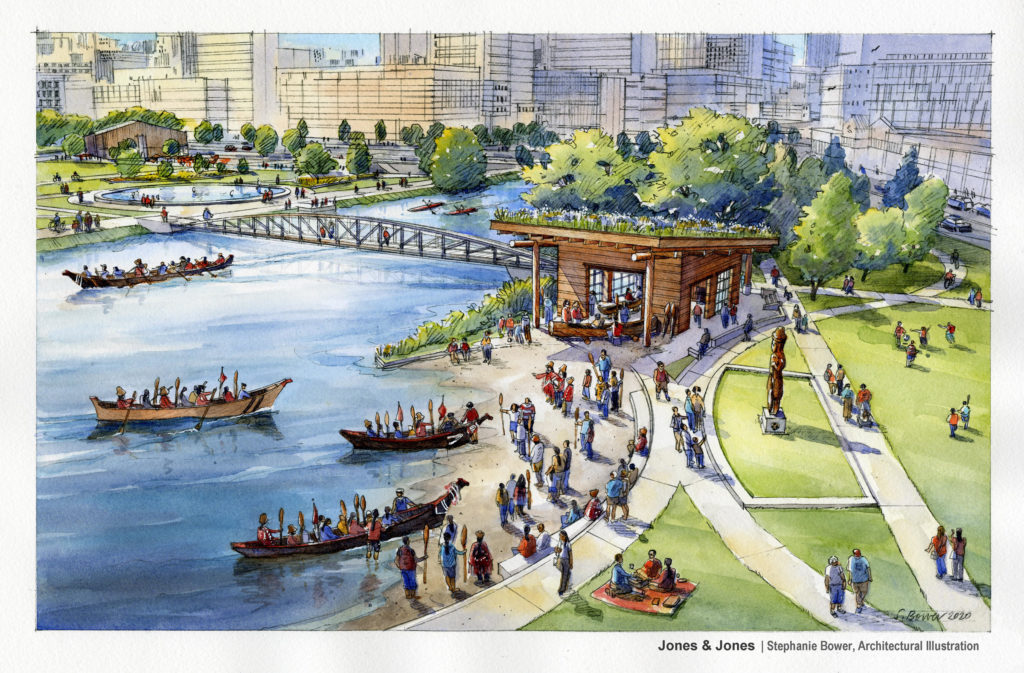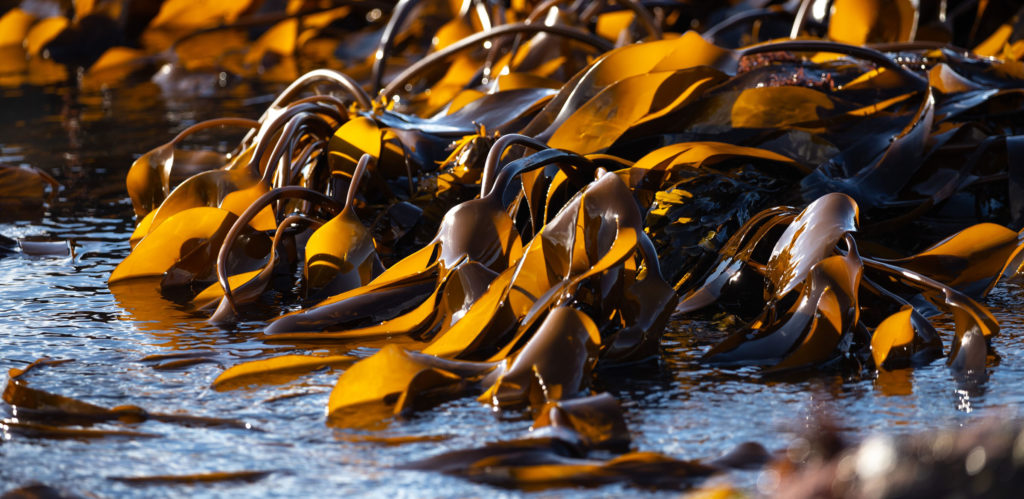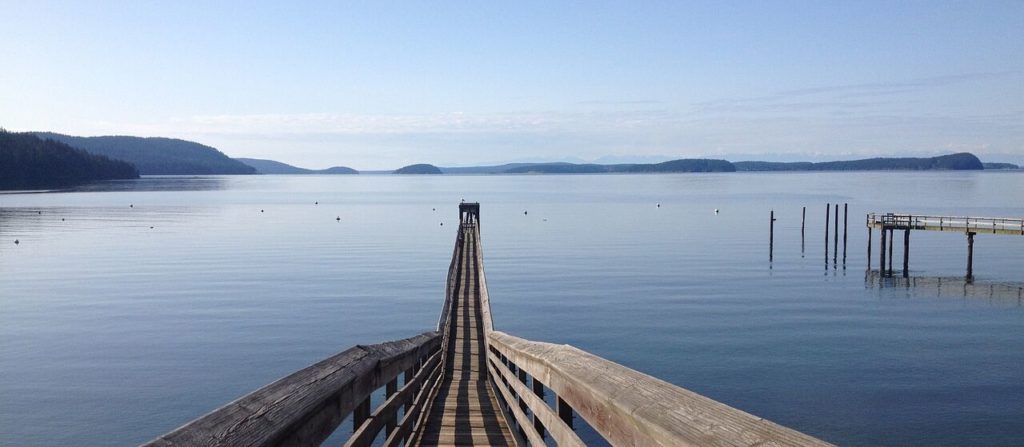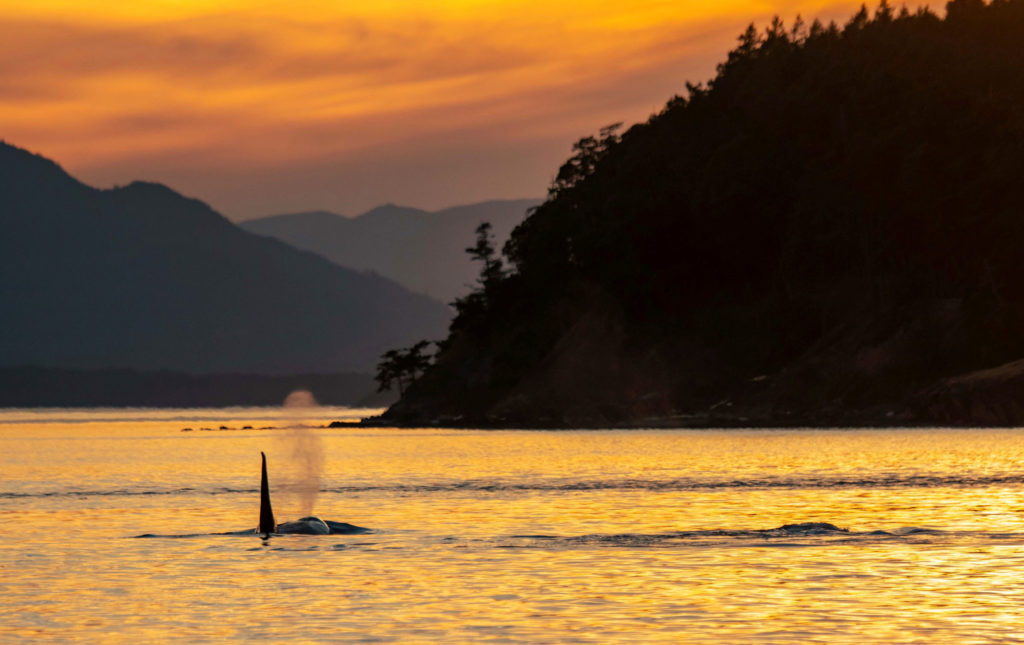
First Nations Canoe Carving House to Open in South Lake Union
South Lake Union has undergone a dramatic makeover in the last decade or so. Now, one more change is coming to the Seattle lakefront to celebrate the maritime heritage of this region’s indigenous people.
Seattle Parks and Recreation and the United Indians of All Tribes Foundation (UIATF) have completed the design stage of a Canoe Carving House, which will be part of the Northwest Native Canoe Center, and now scheduled to begin construction this summer. The community-initiated project will celebrate the canoe culture that is dominant among the Pacific Northwest coastal tribes and will be located on the west shore of Lake Union in Lake Union Park, near the Center for Wooden Boats.
The Carving House will provide insight into different varieties of canoe-carving techniques used for centuries by First Nations cultures in the region. Built with a “living roof,” using local camas plant species, the Carving House will include a carved Welcome Figure on the lake’s beach.
The facility will provide space for an ongoing Native canoe-carving programs and storage for canoes, which will be launched into the lake. Visitors will be able to view the carvers as they build new canoes, while docents will be on hand to explain the Native artisans’ skills and beliefs used over generations.
“This first phase of the Northwest Native Canoe Center has been a dream of ours for many years,” said Mike Tulee, executive director of UIATF. “The facility fits directly into our mission and will provide educational and cultural opportunities that reconnect Indigenous people to their heritage and will strengthen their sense of belonging.”
The project, first proposed in the mid-1990s, went through an extensive design and permitting process in the 2000s, plus a 2015 campaign to secure capital for construction. The work has culminated in the current design of the Carving House, plus a separate, larger facility, called the Welcome Canoe House, featuring educational interpretive displays of Native maritime culture, a gift shop, and a catering kitchen. Combined, the two buildings, made from large, polished timber beams, will encompass about 6,000 square feet of space.
Now that the Carving House project is getting underway, UIATF has launched fundraising efforts for the Welcome House portion of the project. Donations for the next phase can be made via: unitedindians.org.

Port of Seattle, Aquarium Collaborate on Kelp Project
In an effort to document the role kelp forests play in the ecosystem of an underwater urban environment, the Port of Seattle Commission recently approved a project with the Seattle Aquarium to conduct research and survey the extent of kelp forests in the waters of Puget Sound.
The project, which begins this summer, will focus on Seattle’s Elliott Bay waterfront, as well as the heavily trafficked east and west waterways of Seattle Harbor. Funding for the project was included in the Port’s 2022 budget, and the findings are expected the be released to the public early next year, the Port said.
Not only are kelp forests an essential habitat and refuge for countless species of birds, fish, and marine mammals, they also “absorb carbon from the atmosphere, thereby helping to mitigate the impacts of ocean acidification,” said Fred Felleman, commissioner of the Port of Seattle. Erin Meyer, director of conservation programs and partnerships at the Seattle Aquarium, said the new partnership will apply the facility’s underwater survey techniques and technology to protect and restore the health of the urban kelp forest, using artificial intelligence to interpret the data.
The project will make use of the Aquarium’s remotely operated underwater vehicle, known as Blue2, to map the extent of current kelp beds and determine additional sub-tidal monitoring sites where the Aquarium can keep track of changes in the size of the kelp forest. Data collected by Blue2 will be added to information supplied by existing King County water quality monitoring stations to develop a better understanding of the ecological structure of urban kelp forests and study their potential contribution to coastal resilience.
Earlier this year, the Port and the Seattle Aquarium also joined forces to begin work on the new Ocean Pavilion building, an expansion of the Aquarium’s current waterfront location. The new facility, targeted to open in 2024, will add a 48,000-square-foot structure, to be used for educational and environmental marine programs, and a series of gently sloping pedestrian areas to strengthen the connection between downtown Seattle and the waterfront district. For more information on the kelp forest research project, and findings in the future, visit: seattleaquarium.org/ocean-policy-and-advocacy.

State Parks Invests $700K to Prevent Sewage Pump-out in Washington
To help keep the waters of Puget Sound and other state waterways free of sewage contamination, Washington State Parks has added an additional $700,000 in funding to encourage local boaters to dispose of their vessel sewage via or new or upgraded pump-out stations.
The funds will be distributed through grants from the state’s Clean Vessel Act (CVA) Grant Program. Under state law, Puget Sound and many of the adjoining waters are considered No-Discharge Zones for vessel sewage, as determined by the state’s Department of Ecology. The legislation was enacted in 2018 to protect sensitive shellfish habitats and area beaches from contamination.
One of the largest CVA-funded projects will be a $300,000 plan to install a floating restroom at Cutts Island State Park, near Gig Harbor. Other projects involving the building, maintenance, or replacement of dockside pump-out locations will be doled out to the Port of Port Townsend, Tyee Marina in Tacoma, Port Orchard Marina, the Port of Poulsbo, the Port of Kingston, West Sound Marina on Orcas Island, and the City of Chelan. Grant recipients must provide a 25% match and contribute more than $250,000 in state and local funding.
In addition to funding new or replacement pump-out projects, the CVA Grant Program also funds the annual operation and maintenance of more than 100 pump-out and dump station facilities across the state. Last year, more than $400,000 in grant funds were sent towards annual operating and maintenance expenses of these facilities. More information about project specifics and tips on sewage disposal for state boaters can be found at: pumpoutwashington.org.

State Launches Orca Recovery Website
What’s black and white and blue and green all over? Orca.wa.gov, Washington State’s new website for the care, protection, and recovery of Puget Sound’s threatened Southern Resident orca whale population.
The site, launched by the Governor Jay Inslee’s Salmon Recovery Office in May, just in time to promote Whale Awareness Month in June, provides a wealth of information about the state of the Southern Resident population and tips on what boaters can do to ensure that orcas and other marine mammals can thrive.
One of the most useful guides for protecting orca whales is a list of 49 recommendations created by the Southern Resident Killer Whale Task Force over a two-year period from 2018 to 2020. Most of the recommendations involve methods to increase Chinook salmon abundance (the key food source for orcas), decrease disturbance of whales made by vessel traffic noise, reduce exposure to pollution in whale habitats, suggest funding mechanisms to support implementation of whale protections, address climate change and future growth in the region.
Orca.wa.gov is also a clearinghouse for general orca information, such as the current Southern Resident population totals—now just 74 confirmed whales counted, compared with 99 in 1995. While the current count represents a 30-year low in the Southern Resident population, a new calf was discovered in K Pod in April, the first such sighting in that pod since 11 years ago, giving some hope that a rise in population may be underway.
The site contains links to a wide range of resources about whale information, including the Be Whale Wise program, jointly run by British Columbia, Washington State, and the federal government, providing tips on how boaters can maintain a safe distance from orca pods. (This last one may be an especially pertinent reminder given the hefty fines leveled at a pair of local boaters who got too close earlier this summer.) Another resource on the site, called The Whale Trail, provides information on more than 100 viewing sites where visitors can watch orcas along their annual West Coast migration.
“We hope this website will provide valuable information and inspire everyone to join our efforts to save these beloved whales,” said Tara Galuska, orca recovery coordinator for the governor’s office. “There is much work to be done and it will take all of us pulling together to save them.”
Visit the site for further information and resources: orca.wa.gov.


